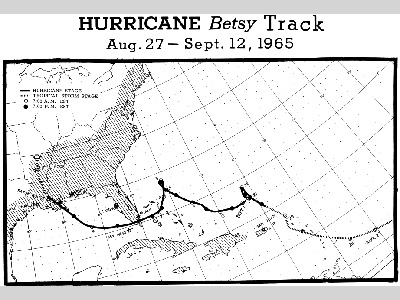Basic Statistics
Dates
Maximum wind speed Minimum pressure Deaths Damage Landfall
August 27- September 14, 1965
250 km/hr (155 mph) 941 mb 76 1.42 Billion U.S. The Bahamas, Florida, Louisiana Hurricane Betsy, which is reported as one of the deadliest and costliest storms in United States history, began as a tropical disturbance photographed by the TIROS weather satellite on August 23, 1965. On 27 August, reconnaissance aircraft recorded a weak tropical depression about 560 kilometers (350 miles) east-southeast of Barbados (this was believed to be the same system). Later that day, the depression was named “Betsy”, and by the afternoon of 29 August, the storm had intensified into a hurricane, 200 miles north-northeast of San Juan, Puerto Rico. Over the next couple of days, the hurricane looped 440 kilometers (275 miles) north of Puerto Rico weakening to a tropical storm. Turning west, on 1 September, the storm regained hurricane status and drifted 560 kilometers (350 miles) east of Daytona Beach, Florida. At this point, the hurricane appeared to be heading toward the Carolinas. However, on 4 September it made a second loop and shifted southwest toward Florida. The hurricane passed over the Bahamas and stalled over Nassau. Winds on Great Abaco Island reached 237 km/h (147 mph). On September 7, Betsy moved toward extreme southern Florida and on 8 September, they hurricane made its first landfall in Key Largo, FL as a Category 3 hurricane.
As the storm moved out of Florida and into the Gulf of Mexico, it shifted once again—this time to the north-northwest- and reintensified into a Category 4 storm with winds up to 250 km/h (155 mph). On the evening of 9 September, the hurricane made its second landfall as a Category 3 hurricane at Grand Isle, LA, just west of the mouth of the Mississippi River. Winds gusted above 160 km/h (100mph) across much of southeast Louisiana, with hurricane-force winds recorded as far inland as Lafayette, LA (~270 kilometers [170 miles] away), and points north. The storm continued through central Louisiana, essentially traveling upriver and causing the Mississippi River at New Orleans to rise by 3 m (10 feet). The river crested in Baton Rouge at 4.6 meters (15.5 feet). By 10 September, the system was over Arkansas with diminishing winds. Shortly after, the system headed toward the Ohio Valley as a tropical storm. Flooding caused by Hurricane Betsy was widespread across the Gulf coast, with storm surge noted as far east as Mobile, AL. Grand Isle, LA saw a 4.8 meter (15.7 foot) surge wash over its northern coast - practically all buildings in Grand Isle were either severely damaged or destroyed. Due to the surge, hundreds of ships, tugs, and barges were sunk or driven aground from New Orleans to Baton Rouge. Eleven shipwrecks blocked 30 miles of the Mississippi River. One barge, which contained enough chlorine to kill tens of thousands of people if released, sank in 18.3 meters (60 feet) of water near the University of Louisiana campus. After weeks of government efforts, the barge was safely located and refloated without incident. The hurricane brought a 3 meter (10 foot) storm surge to New Orleans, producing the city’s worst flooding in decades. The surge was driven into Lake Pontchartrain, just north of New Orleans, and the Mississippi River Gulf Outlet (MRGO), a deep-water shipping channel to the east and south. Levees for the MRGO and on both sides of the Industrial Canal failed, causing dramatic flooding very similar to that which occurred during Hurricane Katrina in 2005. Also similar to Katrina, this flooding overloaded the city’s pumping system, which failed when 90% of the city’s electric power was knocked out. In all, 164,000 New Orleans homes were flooded after the second landfall. Residents fled to their rooftops to escape the rising waters. After an unprecedented relief effort, it was ten days or more before the water level in New Orleans receded and residents could return to their homes. It took even longer to restore flooded houses to a livable condition. Seventy-six total deaths were a direct result of Hurricane Betsy. A total of $1.42 billion ($9.8 billion 2010 USD) in damages were estimated, with most of those damages occurring in Louisiana. Fast Facts:
Sources:
NHC, Hydrometerological Prediction Center (HPC) Memorable Gulf Coast Hurricanes of the 20th Century Arnold Sugg. 1966. The Hurricane Season of 1965. Monthly Weather Review The Major Hurricanes to Affect the Bahamas: Personal Recollections of Some Category 5: The Story of Camille Florida’s Hurricane History Encyclopedia of disasters: Environmental Catastrophes and Human Tragedies Louisiana Hurricane History Todd Shallat. 2000. In the Wake of Hurricane Betsy. Chapter 8 In: Transforming New Orleans and Its Environs. Craig E. Colten, editor Hurricane Betsy Preliminary Report |


